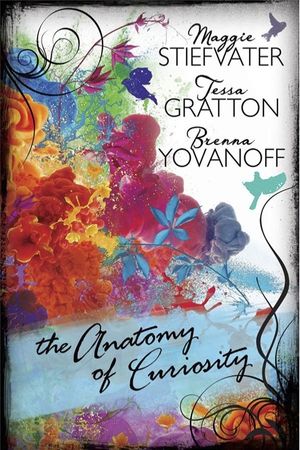
About the Book
- Genres:
- Anthology
- Non Fiction (General)
Cover Story: Portrait Of The Writer’s Brain In Action
The Best For Characterization: “Ladylike” by Maggie Stiefvater
The Best For World-Building: “Desert Canticle” by Tessa Gratton
The Best For Illustrating How A Story Evolves: “Drowning Variations” by Brenna Yovanoff
Bonus Factors: LGBTQ, Pep Talk
Break Glass In Case Of: Writing Rut
Cover Story: Portrait of the Writer’s Brain in Action
This cover is very pretty (although it does remind me of my circa-2004 Photoshop creations) and abstract. I love the explosion of color. While it doesn’t tell you anything about what the book actually is about (which would be hard to convey, I imagine), I think it fits. I assume this is what it looks like to live in the authors’ brains.
The Deal
Stiefvater, Gratton, and Yovanoff each use a short story to illustrate their writing process and style. As writers, each of them focus on and are known for different traits. This look into how the sausage is made is fascinating. Each story deserves one read with the annotations, and one without (although this is a little more difficult with Yovanoff’s selection), to really absorb what the writers set out to accomplish and how they achieved it.
Stiefvater and Gratton, especially, use a lot of annotations to point out specific details that one might not pause to consider while you’re racing to find out what happens. For any aspiring writer who has sat down with a beloved book and wondered just why it’s so good—let alone how you might accomplish the same thing someday—this is an unbelievably useful tool.
Oh, and the stories are good, too.
The Best for Characterization: “Ladylike” by Maggie Stiefvater
Stiefvater introduces her story with the declaration that she’s always been most interested in building rich and “real” characters. Her story, which follows the awkward and lumbering (but sharp) Petra as she reads poetry to an elderly, strangely dangerous woman, specifically details the choices she made to show specific character qualities. This turns up in everything from how Petra climbs the stairs to the elderly lady’s apartment. It’s vividly, lushly written in Stiefvater’s usual style, and the annotations are helpful for dissecting exactly how she does it—and the choices she has to make in order to get her writing up to the quality it is.
The Best for Worldbuilding: “Desert Canticle” by Tessa Gratton
This story was my favorite of the three, and because it is set in a world very unlike our own, Gratton spends a considerable time setting the scene. At the same time, her annotations show us how she tried to weave that worldbuilding into the story. How can you further the plot while avoiding the dreaded info dump? What kind of details does Gratton think best show the daily life of her characters’ cultures? How do you weave the theme into every aspect of the story?
The Best for Illustrating How a Story Evolves: “Drowning Variations” by Brenna Yovanoff
Yovanoff’s story was the least helpful to me, although it was interesting to see how she moves from sketches of ideas to a finished product. Her annotations are the least specific of the three (this is my bias: I like specific and linear things), but the way she approaches a story, particularly the language aspect, is unique.
Bonus Factor: LGBTQ
One of the stories is a sensitive and interesting take on gender and sexuality.
Bonus Factor: Pep Talk
I edit and contribute to FYA’s Inkcouragement feature for aspiring writers, so I’ve been trading in authorial pep talks for the last six months. While the general advice is similar to what one might get from many authors, this book shines in dissecting the stories and process for us. I might throw myself on the couch, thinking “it’s easy for you to say ‘build a character this way,” but when Maggie Stiefvater actually points out the things she did to illustrate Petra and her companion, it makes the whole process seem a lot less intimidating. Instead of clutching my beloved copies of The Raven Cycle, bemoaning the fact that my writing is simply not there yet, I can try to apply the specific and useful advice each author shared. Progress!
Break Glass in Case of: Writing Rut
Are you 300 words into your epic novel, and have been for a year? Do you have some fantasies about how your readers are sure to drown in their own tears after reading your glorious saga, but the reality of writing is interfering with making that a reality? Do most of the scenes consist of “[insert meaningful words here]”? Then you need to pick this up, and watch how the delicious and fully realized sausage starts from discarded bits and pieces that no one wants to eat on their own.
FTC Full Disclosure: I received my free review copy from publisher. This review was originally posted on Kirkus Reviews in exchange for monetary compensation, which did not affect or influence my opinions. The Anatomy of Curiosity is available now.